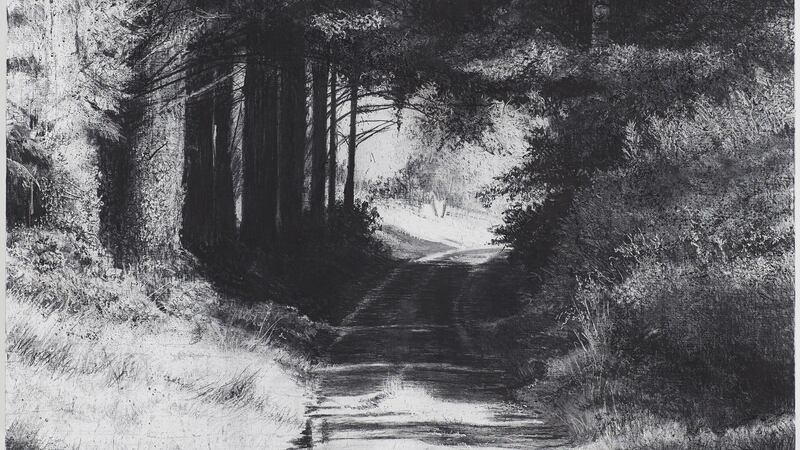THE RESPECTFUL DISTANCE
Michael Canning
Oliver Sears Gallery, Dublin
May 5th-June 16th, oliversearsgallery.com
★★★★
IN A GARDEN I ONCE KNEW
Michael Wann
Cross Gallery, Dublin
Until May 7th, crossgallery.ie
★★★
LEGACY
John Doherty
Taylor Galleries, Dublin
Until May 21st, taylorgalleries.ie
★★★★


Francis Bacon said that you need three things to be an artist. Briefly: technical ability, a subject matter that fascinates you and a knowledge of art history. Michael Canning, Michael Wann and John Doherty meet all three criteria, even as each employs a different, distinctive representational strategy in response to their immediate environments.
Since the turn of the century, Canning has resolutely pursued a single project, making variations on a basic pictorial theme. This has won him a wide following while also perplexing some observers who find his work hard to pigeonhole in terms of contemporary art-world bureaucracy. The basic template of his painting is to situate a large, detailed study of a plant against a flat, receding, agricultural landscape and an expansive sky, usually in the subdued light of dawn or dusk.
Invariably, the landscape is naturalistic but uneventful, a backdrop to the plant, an exactly described specimen as in botanical art. But Canning is at pains to point out that he is not a botanical painter. He picks up plants – wild flowers, herbs, weeds – he happens upon as he walks near his Co Limerick studio, brings them back and paints them from life on to a prepared ground. He knows and recognises many but is not particularly interested in identifying or classifying them, although his work does refer to those processes. Whereas the background landscapes are built up cumulatively in layers, the plants are painted in one go.
He is interested in experience, observation and memory. He aligns himself with the northern European tradition extending back to the Renaissance – evident, perhaps, in his analytical approach to representation (think of Dürer’s celebrated study of a piece of turf), and a pervasive melancholy tone.
Robert O’Byrne has accurately pointed out strong visual links with the 19th-century Northern Irish painter Andrew Nicholl. That Canning has explored such a precisely defined pictorial framework for so long is intriguing, although it is by no means unheard of for an artist to do so. His paintings are elegant constructions, as are his drawings, made by combining several sheets of paper. He originally studied sculpture, and he makes sculptures that, although recognisably related to the paintings, are quite different in approach.
Sidestepping the picturesque
Wann makes images of rural Ireland in which he sidesteps the picturesque. His is an Ireland – he is based in Co Sligo – of dereliction and rain-sodden decay. That may sound grim, but, as with the melancholy edge in Canning's paintings, Wann seems to relish the neglected backwoods and crumbling dwellings, and he has found an audience that shares his feeling for this faded world. He works more in grey than black-and-white, building up densely worked, textural charcoal and wash images. They can veer towards appearing photographic, but he is not interested in photographic effects or methods: he is very hands-on, becoming physically immersed in the surfaces, which have a painterly quality despite the absence of colour.
Woodland holds a particular interest for him. Not just the grand broadleaf expanses around Lissadell, but also isolated specimens and forestry plantations, and common hedgerows and scrubland. He is attentive to the personality and detail of the land, relishing tangled heaps of branches, the unkempt and anomalous, rutted overgrown tracks, the broken patterns of light. It amounts to a distinctive, downbeat, unsentimental take on a subject that could easily be sentimentalised.
John Doherty is also interested in a crumbling, fading Ireland. He is best known for his fine photorealist studies of sections of street frontage in provincial towns, incorporating shops, pubs and – a preoccupation – garages. He was always attentive to the way a group of facades is a series of constructed and painted images, and he relishes the surface qualities of flaking paint, rust, wear and tear.
There is also a regard – not necessarily outright nostalgia – for the disappearing fabric of the small-town landscape with the waning of vernacular architecture and a move towards a more plastic culture of chains, mass-produced signage and synthetic materials. Doherty, who was born in Kilkenny, studied architecture at Bolton Street. When, subsequently, he moved to Australia, painting took over. He never abandoned Ireland and has exhibited regularly with Taylor Galleries. He is now based in west Cork.
His paintings have consistently reflected his concern with the made environment and, more, the hand-made environment. Not the premeditated, carefully planned overall schemes, more the spaces, objects and places we end up living with for practical, functional reasons: hence the small town, small-scale commercial facades, the petrol pumps and storage tanks. The ultra-functional domain of the working harbour has been a long-term preoccupation. Its structures, craft and furniture are entirely practical and also endure the toughest of corrosive environments.
The work in Legacy incorporates all of these concerns. He has in mind a familiar physical fabric "slipping from present into past tense". From a study of the tough, obdurate structure of a Martello tower at Sutton to the peeling red facade of a boarded-up building in Rot and Ruin, we are confronted with ideas of architectural contingency and relentless decay, order and entropy, the making and undoing of the familiar world. Doherty is, as ever, the most skilful and unshowy of painters.















